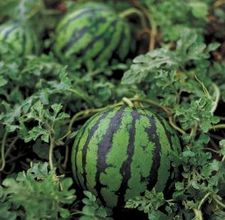Why Did I Get So Few Melons? (Pollination of Melon Plants, by Hand or By Bees)
 Question from Andy:
Question from Andy:
I live in an interior climate zone of Southern California. Last year I planted watermelons but I only got one melon per plant. The melons I got were great, but why did I get so few?
Answer from Pat:
Dear Andy:
You are not the only gardener who has told me they had a low number of fruit on melons on each plant last year. My guess is you didn’t have enough bees in your garden to adequately pollinate your plants. The first question I have is did you see any bees? Bees are having a problem in many areas. (See other Q&A’s on this blog for more details.) Since you didn’t get many melons last year, you will need to watch for bees this year and if they do not appear, then take their place yourself.
Early in the season you will only see male flowers and no female flowers on most varieties of melon, pumpkins, and squash. After a while female flowers will emerge also. (Male flowers have a thin green stem beneath the flower; female flowers have a miniature fruit at the base.) Once female flowers begin to emerge, make sure bees are present also or you will get no fruit. Melons are often pollinated by bumble bees. If you see no bumblebees or honeybees, you will need to pollinate the flowers by hand or use an attractant such as a trademarked ribbon called BeeBow made especially to attract bees. Just tie it onto the plants so that bees flying overhead will get the hint to make a beeline for your plants. Planting a bed a zinnias near your vegetable garden and allowing some earth to be bare without a covering of mulch, are other ways to attract and keep bumblebees, particularly, in your garden. A bed of wildflowers will also help keep bees in your garden along with other benefic ials.
If even these steps fail to attract bees to your garden, then go out early in the morning as soon as the dew has dried and play like a bee. To do this, use a dry, sable, watercolor brush, twirl it around inside the male blossoms picking up the pollen and then go do the same with the female blossoms so you deposit the pollen on the stamen inside them. Another way to do this is to pick a male blossom and remove its petals, then rub the exposed, rode-like, pollen-covered center of the flower, called the stamen, onto the sticky knoblike center of the female blossom, called the stigma, so the pollen sticks to it. After a female blossom is pollinated, its petals will close up and shrivel and the ovary will begin to expand into a fruit. You can then have a much larger harvest, since all well pollinated fruits should mature.


Dear Pat,
Admired your books for many good yr. of gardening. Last yr. in L.A., I built a cage to keep out the rats that disseminated my tomatoes and even ate an entire fava bean plant. Last year was a cool summer, and I got tomatoes, but should have had more and several plants didn’t make it. I see lots of bees on my flowering thyme outside the cage, but no bees inside. I heard about pollinator bees and thought I’d buy them and put a “hive” inside the cage. Can you help me? I can’t find a source in so Cal. Or do you have any other ideas, besides my pollinating them myself?